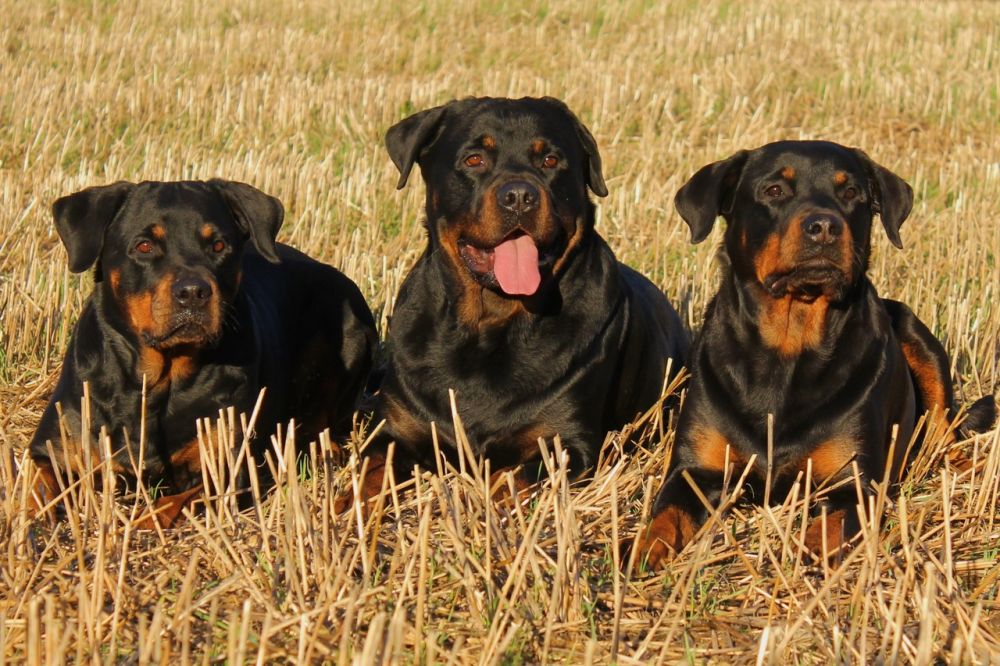
Dog Breed Guide: Rottweiler
Affectionately known as Rotties or Rotts, the Rottweiler is a popular family pet for many people. Originally bred and used by farmers to drive cattle to market and later by butchers to pull carts, the Rottweiler was also one of the earliest police and military dogs.
History of the Rottweiler
Rottweilers are descendants of a large, Mastiff-type dog called a Molossus, that drove the cattle for the Romans as they marched to Germany. These big dogs mated with dogs they met along the way, and the basis for new breeds was formed. More than 600 years later, the inhabitants of a town discovered, while they were doing excavations for a new church, the red tiles of one of the villas that the Romans had built there. This discovery was the inspiration for the new name for the town, das Rote Wil, or the red tile.
Rottweilers flourished in the area, drove cattle to the town for farmers, and also pulled the heavy meat-laden carts for butchers. Cattlemen put their money in bags around the Rottweiler's necks when they returned home to keep their earnings safe from robbers. The Rottweiler almost became extinct when rail was eventually used to transport cattle. This situation changed in 1901, however, when the Rottweiler and Leonberger Club was established, and breeding started in earnest again, with the Rottweiler at the time being used for police work, for which it was ideal.
The breed started becoming very popular after WWII, and today, the Rottweiler is one of the most popular breed choices for families all over the world.
General Physical Characteristics of Rottweilers
Rottweilers are large, powerful dogs, with females weighing between 85 and 115 pounds and about 22 to 25 inches tall at the shoulder and males between 95 and 130 pounds and around 24 to 27 inches tall at the shoulder.
They have a double coat that is short, coarse, and straight. They are always black in color, with markings ranging in shades from rust to mahogany, usually over the eyes, on cheeks, each side of the muzzle, as well as on the chest and legs and under the tail. Tan lines that look like pencil marks are also found on the toes.
Temperament and Character of the Rottweiler
The Rottweiler is a strong and intelligent dog with a true and loving heart and warm eyes that reflect a mellow yet alert and fearless expression. He is calm and confident and aloof toward strangers but never fearful or timid. When all these characteristics come together, the Rottweiler is not only a natural, mellow guard dog, ideal for the military, police, and customs work, but also as a friend and protector for a family.
Their natural instinct to protect their family and property can make the Rottweiler extremely ferocious, so it is essential for them to be trained properly early in life to ensure that they become the loving guardian they are meant to be, rather than a dangerous bully. A Rottie that is not properly trained, can also become overly protective, which will make him aggressive toward everyone he meets, and not just bad guys.
Rottweilers get along very well with children if they grow up with them, but the children must be taught how to handle and respect dogs. Rottweilers have a herding instinct and will bump against children to herd them. Although not intentional, this bump could cause toddlers to fall down and get hurt. The breed also has a strong prey drive, and might get too excited when children run around and play. Rottweilers should not be left unsupervised when playing with children.
Rotties are fine with other pets, as long as they have been raised together. New pets introduced into a home with an adult Rottweiler could cause problems, especially dogs of the same sex. Rotties should always be on a leash when taken for a walk, and it is not a good idea at all, to take a Rottweiler to an off-leash dog play park.
Life Span of the Rottweiler
The life span of a Rottie is from 8 to 11 years.
Common Health and Personality Issues in Rottweilers
Generally, the Rottweiler is a healthy dog, but just like all other breeds, is prone to certain illnesses. However, not all Rotties will get any or all of the following diseases:
- Elbow Dysplasia – an inherited disease involving the malformation of the elbow joint
- Hip Dysplasia – when the ball of the femur does not fit properly into the socket of the hip joint
- Osteosarcoma – an aggressive type of bone cancer
- Aortic Stenosis/Sub-aortic Stenosis (AS/SAS) – a common heart defect that sometimes occurs in Rottweilers
- Panosteitis (Pano) – also sometimes called growing pains since it only occurs in puppies about 4 months old. The usual symptom is lameness that is more often than not treated with simple rest, but if limping occurs, then it’s a good idea to consult a vet
- Gastric Dilatation-volvulus (GDV), also called Bloat or Torsion – a life-threatening disease that can affect large, deep-chested dogs, usually when they are fed one large meal a day, then drink a large amount of water or exercise vigorously. The stomach becomes distended with air or gas and then twists on it's own axis. The dog will die if medical attention isn’t sought immediately.
- Allergies – a common medical condition in most breeds, and caused through contact, food, or airborne allergies
- Hypothyroidism – caused by deficiency of the thyroid hormone in the body
Rottweilers tend to eat too much, so their food intake should be carefully monitored to prevent them from becoming obese.
